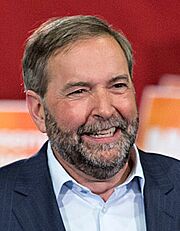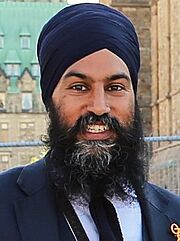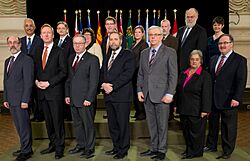New Democratic Party facts for kids
Quick facts for kids
New Democratic Party
Nouveau Parti démocratique
|
|
|---|---|
 |
|
| Abbreviation | NDP NPD |
| Leader | Don Davies (interim) |
| President | Mary Shortall |
| National director | Lucy Watson |
| Deputy leader | Alexandre Boulerice |
| House leader | Alexandre Boulerice |
| Founded | August 3, 1961 |
| Preceded by |
|
| Headquarters | Ottawa, Ontario |
| Youth wing | Canada's Young New Democrats |
| Membership (2017) | |
| Ideology |
|
| Political position | Centre-left to left-wing |
| International affiliation | Progressive Alliance |
| Union affiliate | Canadian Labour Congress |
| Colours | Orange |
| Provincial and territorial wings | |
| Senate |
0 / 105
|
| House of Commons |
7 / 343
|
The New Democratic Party (NDP) is a major political party in Canada. It is often described as a social democratic party. This means it believes in a mix of government programs and private businesses. The NDP is on the centre-left to left-wing side of Canadian politics. This places it to the left of the Liberal Party.
The NDP was started in 1961. It was formed by the Co-operative Commonwealth Federation and the Canadian Labour Congress. As of 2025, the NDP is the fourth-largest party in the House of Commons. It currently holds seven seats.
The NDP's federal and provincial (or territorial) branches work closely together. They even share members. The NDP has never won the most seats in federal elections. So, it has never formed the government of Canada. From 2011 to 2015, it was the Official Opposition. This means it was the main party against the government. Other times, it has been the third or fourth-largest party.
However, the NDP has often held the balance of power. This happens when no single party has a majority of seats. In these times, the NDP has had a lot of influence. It has helped pass laws during minority governments led by the Liberals. NDP branches have also formed governments in six provinces and one territory.
The NDP supports a mixed economy. This means a mix of private and public control. They want more welfare programs. They also support LGBTQ rights and international peace. Protecting the environment is also important to them. The NDP wants to expand Canada's universal healthcare system. They want it to include dental care, mental health care, eye and hearing care, and prescription drugs.
Contents
History of the NDP
The New Democratic Party has a rich history. It grew from earlier movements.
How the NDP Started
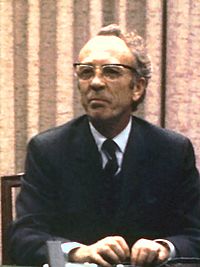
In 1956, two large labour groups joined to form the Canadian Labour Congress (CLC). Soon after, the CLC started talking with the Co-operative Commonwealth Federation (CCF). They wanted to create a new political party. This new party would bring together workers and left-leaning groups.
In 1958, a special committee was formed. It was called the National Committee for the New Party (NCNP). This committee worked for three years to build the new party. Many "New Party Clubs" were set up across Canada. People who shared similar ideas could join these clubs.
In 1961, the New Democratic Party was officially born. This happened at a big meeting where they decided on the party's rules and goals. Tommy Douglas was chosen as the first leader. He was already famous as the Premier of Saskatchewan.
Leaders of the 20th Century
After Tommy Douglas, David Lewis became leader in 1971. The NDP supported the Liberal government from 1972 to 1974. They helped pass important laws. These included better pensions and creating Petro-Canada. However, in the 1974 election, the NDP lost many seats. Lewis then resigned.
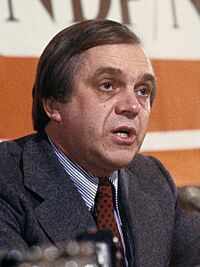
Ed Broadbent became leader in 1975. He led the party for 14 years. Under him, the NDP focused on everyday issues for Canadians. In 1979, the NDP helped bring down the government. This led to an election in 1980. In the 1988 election, the NDP won 43 seats. This was a record for the party at that time. Broadbent stepped down in 1989.
Audrey McLaughlin became the next leader. She was the first woman to lead a major federal political party in Canada. She tried to gain more support in Quebec. The NDP won its first election in Quebec in 1990. However, in the 1993 election, the NDP had a very tough time. They won only nine seats. This was their lowest number of seats since the party started. Many blamed unpopular NDP governments in some provinces.
Alexa McDonough took over as leader in 1995. In the 1997 election, the party improved. They won 21 seats. They also gained support in Atlantic Canada. This was a region where they had not been strong before. In the 2000 election, the NDP focused on healthcare. But they lost some support and ended up with 13 seats. McDonough resigned in 2002.
Leaders of the 21st Century
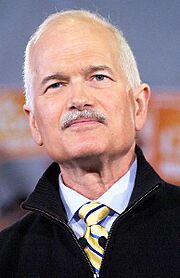
Jack Layton became leader in 2003. In the 2004 election, the NDP gained more votes. They won 19 seats. The Liberals formed a minority government. This meant the NDP could influence laws. They pushed for things like fighting healthcare privatization.
In 2005, Layton helped bring down the Liberal government. This led to an election in 2006. The NDP won 29 seats. This was a big increase. They gained seats in British Columbia, Ontario, and the Northwest Territories. The Conservatives formed a minority government. The NDP often voted against the government. But they also worked together on some issues.
In the 2008 election, the NDP won 37 seats. This was their best result since 1988. They even won a seat in Alberta for only the second time.
In the 2011 federal election, the NDP made history. They won a record 103 seats. This made them the Official Opposition for the first time ever. They had a huge breakthrough in Quebec. They won 59 out of 75 seats there. This meant most of their MPs were from Quebec. This election also saw the Liberal Party fall to its worst-ever result.
Sadly, Jack Layton announced in July 2011 that he had a new cancer. He passed away on August 22, 2011.
Tom Mulcair was elected as the new leader in March 2012. In the 2015 election, the NDP lost many seats. They fell back to third place. They won 44 seats. This was still the second-best result in the party's history. But they lost seats in Ontario and Quebec. The Liberals formed a majority government.
After the election, Mulcair faced criticism. In April 2016, party members voted that he should step down. This was the first time a federal leader in Canada was removed by a confidence vote. Mulcair agreed to stay until a new leader was chosen.
Jagmeet Singh became the new leader on October 1, 2017. He was the first person from a visible minority group to lead a major Canadian federal party. He won a by-election in 2019 to become a Member of Parliament.
In the 2019 federal election, the NDP won 24 seats. This was their worst result since 2004. They lost many seats in Quebec and Saskatchewan. After this election, the NDP held the balance of power again. The Liberals had a minority government. During the COVID-19 pandemic, the NDP used its power. They pushed the Liberals to give more financial help to Canadians.
In the 2021 federal election, the NDP gained a few more seats. They won 25 ridings. They picked up seats in Alberta and British Columbia. Overall, the balance of power in the House of Commons did not change.
In March 2022, the NDP made a deal with the Liberal Party. This was a "confidence and supply" agreement. It meant the NDP would support the Liberals on key votes. In return, the Liberals agreed to work on NDP priorities. These included a national dental care program and progress towards a national pharmacare program. This deal ended in September 2024.
After Mark Carney became prime minister, the NDP's support in polls dropped. In the 2025 federal election, the NDP had its worst result ever. They lost 17 of their 24 seats. They now have only 7 seats. This means they lost official party status in the House of Commons. Jagmeet Singh lost his own riding. He announced he would resign as leader. Don Davies became the interim leader.
What the NDP Believes In
The NDP was formed in 1961. It came from the Canadian Labour Congress (CLC) and the Co-operative Commonwealth Federation (CCF). The CCF started with ideas from farmers and socialists. The NDP is now a modern social democratic party. It is open to many different ideas and groups.
The NDP also cares about New Left issues. These include LGBT rights, international peace, and protecting the environment. The party supports a mixed economy. They also want more welfare programs. Some members of the party believe in democratic socialism. The NDP is part of the Progressive Alliance. This is a group of progressive and social democratic parties around the world.
Party Goals
The NDP's rules say that both social democracy and democratic socialism guide the party. They are proud of their history. They see themselves as continuing the work of the CCF. The party wants to build a more fair and equal Canada. They also want a sustainable Canada within a global community. They work with farmers, workers, women's groups, human rights groups, and Indigenous peoples.
Healthcare Plans
The NDP is very committed to public healthcare. They want a national, universal public program for prescription drugs. This would mean all Canadians could get the medicine they need with their health card. They believe this would save money and make people healthier.
The party also wants to expand healthcare services. They want the national system to cover dental care, mental health care, eye and hearing care, and infertility treatments. They point out that many Canadians cannot afford dental care. This forces them to go to hospital emergency rooms when they have severe pain.
Views on Palestine
The NDP supports the idea of a Palestinian state. In March 2024, the House of Commons passed a motion from the NDP about Palestine. The motion called for the government to work towards creating a Palestinian state. This would be part of a negotiated two-state solution.
NDP's Successes in Elections
The NDP has always had members in the House of Commons. From 1965 to 1993, it was the third-largest party. Then it dropped to fourth place. It lost its official party status in 1993. The NDP regained official status in 1997.
The NDP had a lot of influence during minority Liberal governments. This happened under Lester B. Pearson (1963–68) and Pierre Trudeau (1972–74). They also played a similar role during Liberal and Conservative minority governments from 2004 to 2011. In the 2011 election, the NDP became the second-largest party. They formed the Official Opposition.
NDP parties at the provincial level have formed governments in six provinces and one territory. As of 2025, the NDP governs British Columbia and Manitoba. It is the Official Opposition in Alberta, Nova Scotia, Ontario, and Saskatchewan. The NDP has members in every provincial legislature except New Brunswick, Prince Edward Island, and Quebec.
The NDP does not organize at the municipal level. This means they don't have official party campaigns for mayors or city councillors. For example, former Toronto mayor David Miller was an NDP member. But his mayoral campaigns were not officially linked to the party. The same is true for current Toronto mayor Olivia Chow.
Provincial and Territorial NDP Groups
Unlike most other Canadian federal parties, the NDP is closely connected with its provincial and territorial parties. If you are a member of a provincial NDP group, you are automatically a member of the federal party. This means you cannot be a member of different parties at the federal and provincial levels. The minimum age to join can vary by province, from 12 to 14 years old.
There have been a few exceptions. In Nunavut and the Northwest Territories, the legislatures are non-partisan. This means there are no official political parties. So, the federal NDP is promoted by local groups there.
In Quebec, the New Democratic Party of Quebec was linked to the federal party until 1989. They separated when the Quebec party started supporting Quebec independence. For many years, the federal NDP only had a Quebec Section. In 2014, a new New Democratic Party of Quebec was formed. It was a federalist party and not linked to the federal NDP. This party ended in late 2024.
The New Democratic Party currently leads the governments in British Columbia and Manitoba. They have also led governments in Alberta, Nova Scotia, Ontario, Saskatchewan, and Yukon in the past.
Current Members of Parliament
| Name | Riding | Province/territory | MP since | Predecessor |
|---|---|---|---|---|
| Alexandre Boulerice | Rosemont—La Petite-Patrie | Quebec | May 2, 2011 | Bernard Bigras |
| Don Davies | Vancouver Kingsway | British Columbia | October 14, 2008 | David Emerson |
| Leah Gazan | Winnipeg Centre | Manitoba | October 21, 2019 | Robert-Falcon Ouellette |
| Lori Idlout | Nunavut | Nunavut | September 20, 2021 | Mumilaaq Qaqqaq |
| Gord Johns | Courtenay—Alberni | British Columbia | October 19, 2015 | riding created |
| Jenny Kwan | Vancouver East | British Columbia | October 19, 2015 | Libby Davies |
| Heather McPherson | Edmonton Strathcona | Alberta | October 21, 2019 | Linda Duncan |
Federal Leaders of the NDP
Here is a list of the leaders of the New Democratic Party since 1961. This includes leaders who served temporarily.
| Portrait | Leader (birth–death) |
Riding | Took office | Left office | Deputy |
|---|---|---|---|---|---|
 |
Tommy Douglas (1904–1986) |
Weyburn (Saskatchewan) Burnaby—Coquitlam Nanaimo—Cowichan—The Islands |
August 3, 1961 | April 24, 1971 | |
 |
David Lewis (1909–1981) |
York South | April 24, 1971 | July 7, 1975 | |
 |
Ed Broadbent (1936–2024) |
Oshawa–Whitby Oshawa |
July 7, 1975 | December 5, 1989 | |
 |
Audrey McLaughlin (b. 1936) |
Yukon | December 5, 1989 | October 14, 1995 | |
 |
Alexa McDonough (1944–2022) |
Halifax Fairview (Nova Scotia) Halifax |
October 14, 1995 | January 25, 2003 | |
 |
Jack Layton (1950–2011) |
Toronto–Danforth | January 25, 2003 | August 22, 2011 | Bill Blaikie (2004–2008) Tom Mulcair (2007–2011) Libby Davies (2007–2015) |
 (Interim) |
Nycole Turmel (b. 1942) |
Hull—Aylmer | July 28, 2011 | March 24, 2012 | Tom Mulcair (2007–2011) Libby Davies (2007–2015) |
 |
Tom Mulcair (b. 1954) |
Outremont | March 24, 2012 | October 1, 2017 | Libby Davies (2007–2015) Megan Leslie (2012–2015) David Christopherson (2012–2019) |
 |
Jagmeet Singh (b. 1979) |
Bramalea—Gore—Malton (Ontario) Burnaby South |
October 1, 2017 | May 5, 2025 | David Christopherson (2012–2019) Sheri Benson (2019) Alexandre Boulerice (2019–present) |
 (Interim) |
Don Davies (b. 1963) |
Vancouver Kingsway | May 5, 2025 | Alexandre Boulerice (2019–present) |
NDP Election Results in the House of Commons
This table shows how the NDP has done in federal elections. It lists the leader, votes, percentage of votes, and number of seats won.
| Election | Leader | Votes | % | Seats | +/− | Position | Status |
|---|---|---|---|---|---|---|---|
| 1962 | Tommy Douglas | 1,044,754 | 13.57 |
19 / 265
|
Fourth party | ||
| 1963 | 1,044,701 | 13.22 |
17 / 265
|
Fourth party | |||
| 1965 | 1,381,658 | 17.91 |
21 / 265
|
Third party | |||
| 1968 | 1,378,263 | 16.96 |
22 / 264
|
Third party | |||
| 1972 | David Lewis | 1,725,719 | 17.83 |
31 / 264
|
Third party | ||
| 1974 | 1,467,748 | 15.44 |
16 / 264
|
Third party | |||
| 1979 | Ed Broadbent | 2,048,988 | 17.88 |
26 / 282
|
Third party | ||
| 1980 | 2,165,087 | 19.77 |
32 / 282
|
Third party | |||
| 1984 | 2,359,915 | 18.81 |
30 / 282
|
Third party | |||
| 1988 | 2,685,263 | 20.38 |
43 / 295
|
Third party | |||
| 1993 | Audrey McLaughlin | 939,575 | 6.88 |
9 / 295
|
No status | ||
| 1997 | Alexa McDonough | 1,434,509 | 11.05 |
21 / 301
|
Fourth party | ||
| 2000 | 1,093,748 | 8.51 |
13 / 301
|
Fourth party | |||
| 2004 | Jack Layton | 2,127,403 | 15.68 |
19 / 308
|
Fourth party | ||
| 2006 | 2,589,597 | 17.48 |
29 / 308
|
Fourth party | |||
| 2008 | 2,515,288 | 18.18 |
37 / 308
|
Fourth party | |||
| 2011 | 4,508,474 | 30.63 |
103 / 308
|
Official Opposition | |||
| 2015 | Tom Mulcair | 3,441,409 | 19.71 |
44 / 338
|
Third party | ||
| 2019 | Jagmeet Singh | 2,903,722 | 15.98 |
24 / 338
|
Fourth party | ||
| 2021 | 3,036,346 | 17.83 |
25 / 338
|
Fourth party (2021–2022, 2024–2025) | |||
| Confidence and supply (2022–2024) |
|||||||
| 2025 | 1,236,317 | 6.29 |
7 / 343
|
No status |
Logos of the NDP
| 1961 | 1961–1984 | 1984–1997 | 1997–2004 | 2004–2012 | 2012–present |
|---|---|---|---|---|---|
 |
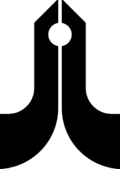 |
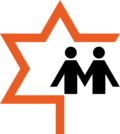 |
See also
 In Spanish: Nuevo Partido Democrático para niños
In Spanish: Nuevo Partido Democrático para niños
- List of NDP Members of Parliament
Related Groups
- Broadbent Institute
- Douglas–Coldwell Foundation
NDP Groups in Provinces and Territories
- BC NDP
- Alberta NDP
- Saskatchewan NDP
- Manitoba NDP
- Ontario NDP
- New Brunswick NDP
- Nova Scotia NDP
- PEI NDP
- Newfoundland and Labrador NDP
- Yukon NDP


